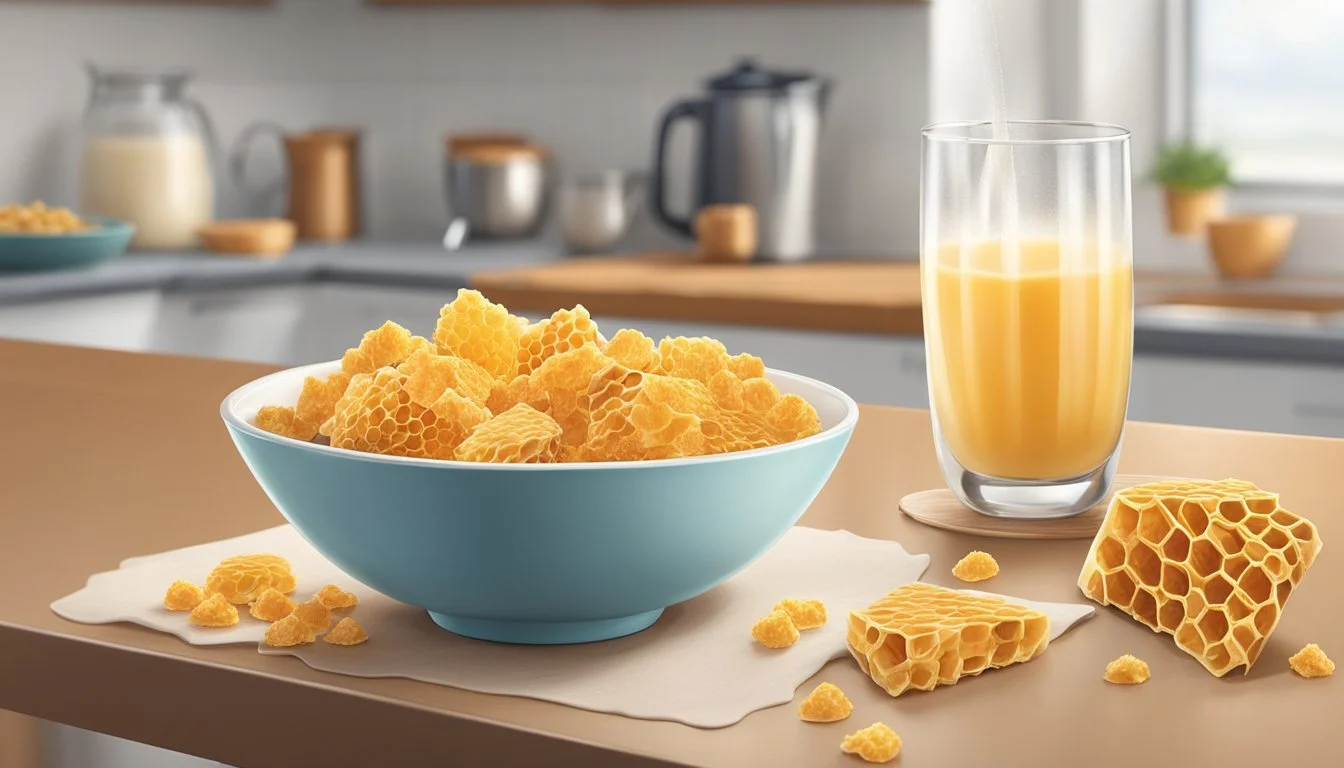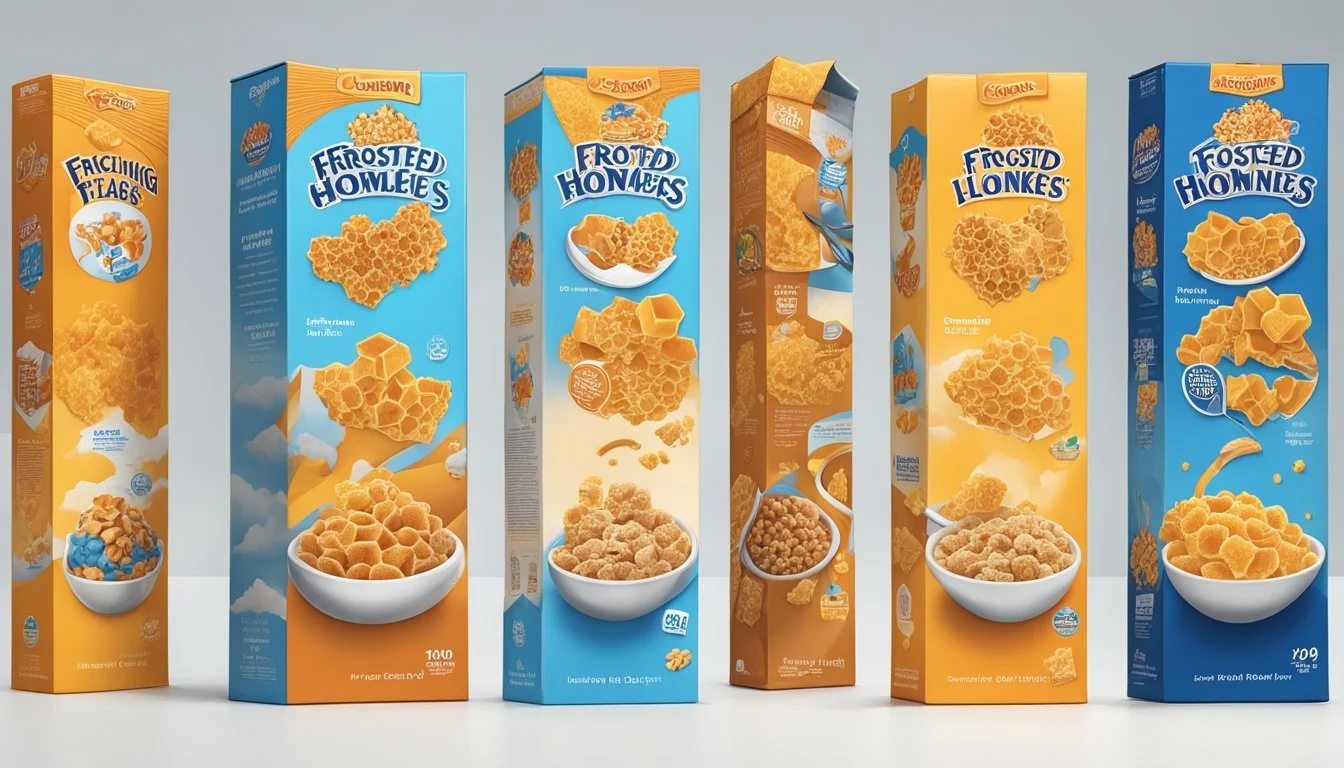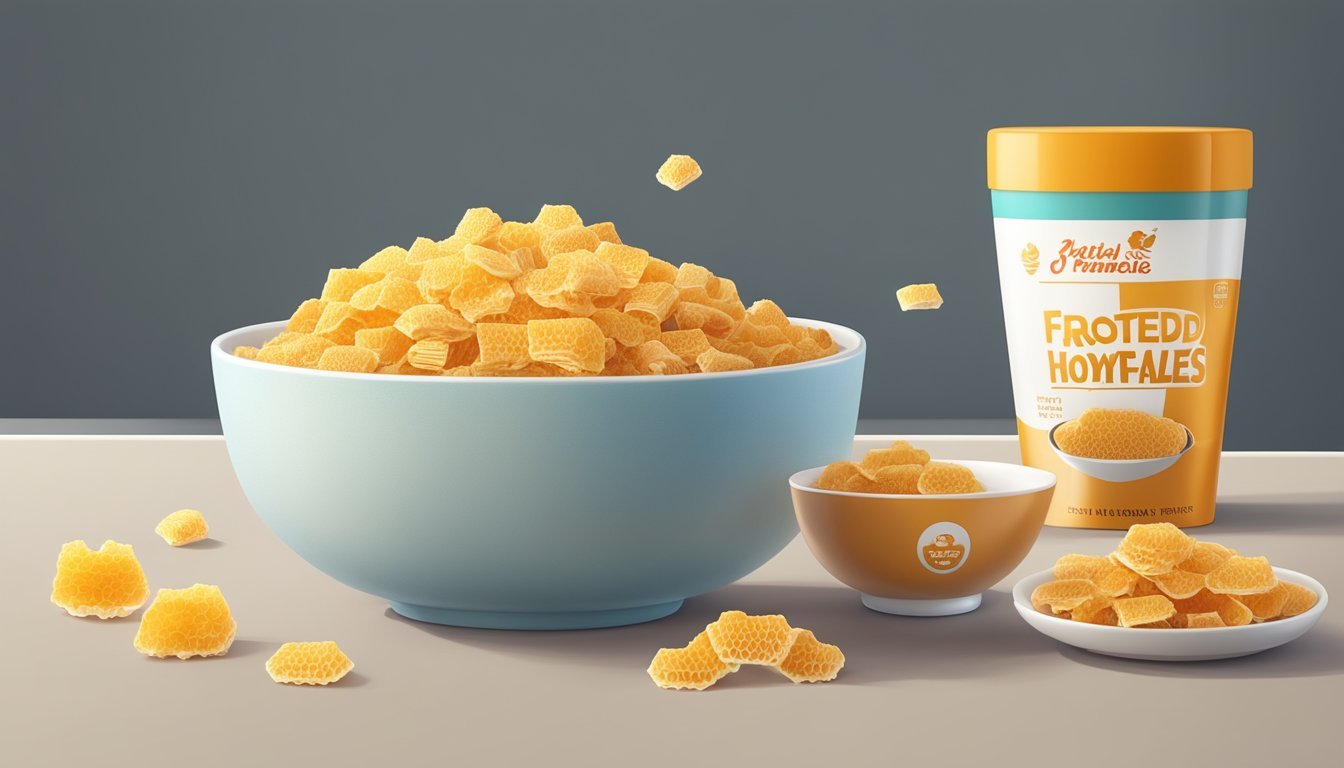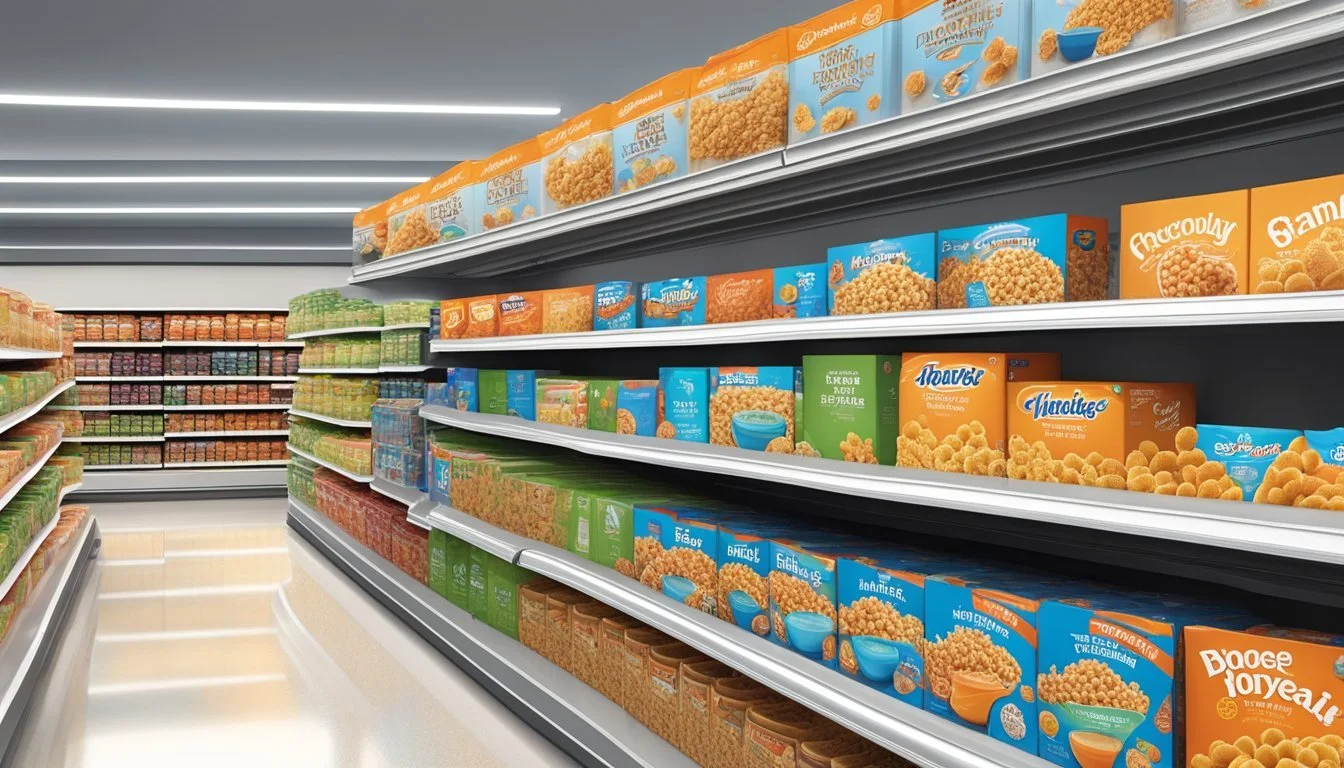Frosted Flakes vs Honeycomb
A Nutritional Comparison
This Article is Part of Our Breakfast Cereal Guide with Details on Frosted Flakes Nutrition and Honeycomb Nutrition
When choosing between Frosted Flakes and Honeycomb, cereal enthusiasts often wonder which one offers a healthier start to their day. Frosted Flakes, known for their sugary coating, provide a quick burst of energy but also come with higher sugar content. On the other hand, Honeycomb presents a lighter, honey-infused flavor with slightly less sugar, which might make it a preferable option for those monitoring their sugar intake.
Comparing the nutritional profiles, Frosted Flakes includes a higher concentration of certain vitamins and minerals, boosting its nutritional value. Honeycomb, while slightly lower in overall vitamins, still offers a balanced mix of essential nutrients. Both cereals have their unique flavor profiles and appeal, making the choice between them contingent on personal taste and dietary preferences.
For those trying to make an informed decision about their breakfast choices, this comparison sheds light on the key differences between Frosted Flakes and Honeycomb. The health implications of each choice can guide readers to select the cereal that best aligns with their nutritional goals and taste preferences.
History and Brand Overview
Frosted Flakes and Honeycomb Cereal are two iconic breakfast options that have distinct histories and development paths. This section will detail the origins and evolution of these cereals.
Origins of Frosted Flakes
Frosted Flakes, produced by Kellogg's, made their debut in 1952. Initially named "Sugar Frosted Flakes," this new cereal was a sweetened variant of Corn Flakes. Kellogg's aimed to create a tasty and sugary breakfast option that would appeal to children and adults alike.
By 1983, the "Sugar" was dropped from the name as part of a broader move to address growing health concerns about sugar in diets. Despite the name change, the cereal itself remained largely the same, retaining its sugary coating and crunchy texture.
The brand's mascot, Tony the Tiger, became an enduring symbol of the cereal, known for his catchphrase "They're Grrreat!" This strong branding helped in maintaining the cereal's popularity over the decades.
Development of Honeycomb
Honeycomb Cereal, created by Post Consumer Brands, was introduced in 1965. The cereal was unique for its honeycomb-shaped pieces, which were designed to appeal to children through their fun shape and sweet flavor.
Marketed as a cereal made with real honey, Honeycomb quickly gained a following. The cereal also featured memorable advertising campaigns, including characters like the Honeycomb Kid, which helped in establishing a strong brand identity.
Over the years, Honeycomb underwent various changes in its recipe and marketing strategies, aiming to balance the needs for taste and nutrition. It remained a staple in many households, beloved for its distinctive shape and honey sweetness.
Through these evolutions, both Frosted Flakes and Honeycomb have solidified their places in breakfast culture, each carving out a unique niche.
Nutritional Comparison
This section looks at significant nutritional differences between Frosted Flakes and Honeycomb cereals. It covers caloric content, sugar and sweeteners, protein and fiber content, vitamin and mineral fortification, and fat analysis.
Caloric Content
Frosted Flakes has 110 calories per serving, while Honeycomb Cereal also provides 110 calories per serving. Both cereals are relatively low-calorie options, making them suitable for portion-controlled diets.
Despite identical caloric content, other nutritional elements differ. Calories come from carbohydrates, proteins, and fats. Therefore, understanding the sources of these calories in each cereal is crucial for those monitoring specific macronutrient intake.
Sugar and Sweeteners
Frosted Flakes is known for its sweet taste, containing 10g of sugar per serving. The sugar mainly comes from added sweeteners, which enhance its flavor but increase sugar intake.
Honeycomb Cereal contains 9g of sugar per serving. Although it’s slightly less sugary than Frosted Flakes, it still falls into high-sugar breakfast options. For individuals mindful of sugar consumption, neither cereal represents a low-sugar choice.
Protein and Fiber Content
Frosted Flakes offers 1g of protein and negligible fiber content per serving. This makes it a less optimal choice for those seeking high-protein, high-fiber breakfast options.
Honeycomb Cereal similarly contains 1g of protein and low fiber content. Fiber aids in digestion and protein is essential for muscle repair, but both cereals fall short in providing significant amounts of these nutrients compared to other breakfast choices.
Vitamin and Mineral Fortification
Frosted Flakes is enriched with several vitamins and minerals, including Iron, Vitamin B6, Vitamin B12, Vitamin B3, Vitamin B1, Vitamin B2, and Vitamin C. These fortifications help meet daily nutritional requirements.
Honeycomb Cereal excels in Zinc, containing 31 times more Zinc than Frosted Flakes. It also provides Vitamin A RAE and Vitamin D. This makes it a better option for boosting immunity and bone health due to higher levels of these specific nutrients.
Analyzing Fats
Frosted Flakes contains negligible fats, including a minimal amount of saturated fats. This can be beneficial for those watching their fat intake.
Honeycomb Cereal also has a low-fat profile, similarly containing minimal saturated fats. Both cereals are suitable for low-fat diets. However, neither offers significant healthy fats, such as omega-3s, which are beneficial for heart health.
In conclusion, both cereals offer advantages and drawbacks depending on individual nutritional needs. Frosted Flakes is richer in certain vitamins, while Honeycomb is better for Zinc and certain fat-related concerns.
Product Variants and Flavors
Frosted Flakes and Honeycomb each offer a variety of flavors intended to cater to different tastes. These variations not only add excitement but also provide options to fit diverse preferences.
Frosted Flakes Varieties
Kellogg's Frosted Flakes has expanded its original offering to include several exciting variants. The classic Frosted Flakes known for its sweet and crispy texture remains a favorite.
Additional flavors such as Chocolate Frosted Flakes and Cinnamon Frosted Flakes have been introduced to provide more choices. These flavors maintain the signature crunch while offering a distinct twist.
Special editions like Strawberry Milkshake Frosted Flakes add uniqueness. Limited-time holiday-themed flavors ensure there is always something new.
Kellogg's has also developed healthier options, reducing sugar content or adding whole grains without compromising the taste. These choices aim to appeal to health-conscious consumers.
Honeycomb Flavor Expansion
Honeycomb by Post has been a nostalgic cereal choice for many, and it has seen some exciting additions to keep the brand fresh.
Apart from the signature honey flavor, Chocolate Honeycomb has been introduced for those who prefer a richer taste. This variant blends the iconic honey sweetness with a chocolatey punch.
Seasonal and limited-edition flavors like Cinnamon & Maple Honeycomb provide a unique spin on the original. These flavors specifically target customers looking for a diverse taste experience.
Post has also introduced Honeycomb Medley, combining various flavors and textures in one box. This variant reflects a trend towards mixing tastes to create something distinctive.
Each flavor expansion reflects attempts to innovate while respecting the core characteristics that made these cereals beloved.
Health and Diet Considerations
Both Frosted Flakes and Honeycomb cereals bring varying health and diet values. When choosing between them, considerations like gluten-free options, dietary impact, and potential allergens become important.
Gluten-Free Options
Frosted Flakes and Honeycomb cereals are not gluten-free. Both contain ingredients derived from wheat or barley. Therefore, individuals with celiac disease or gluten intolerance should avoid these cereals. For those needing gluten-free breakfast options, alternatives such as rice-based cereals or those specifically labeled as gluten-free are better choices.
Ensuring adherence to a gluten-free diet is crucial for health, especially for those with gluten sensitivities.
Impact on Diet Plans
From a dietary standpoint, each cereal carries its implications. Frosted Flakes tend to be higher in added sugars, which might not be ideal for low-glycemic index diets. They are enriched with vitamins, including iron and B vitamins. However, they have 1.0 grams of dietary fiber per serving.
Honeycomb, on the other hand, offers zero grams of dietary fiber, which may not support digestive health as effectively. It is higher in Zinc, Vitamin A, and Vitamin D.
For low-carb or low-calorie diets, neither option is particularly aligned, but Honeycomb has a slightly lower carbohydrate count. Careful consideration should be given to these cereals’ sugar content if aiming for a healthier breakfast.
Allergy Information
Allergies to ingredients in breakfast cereals are not uncommon. Frosted Flakes and Honeycomb contain wheat derivatives, posing a risk for those with wheat allergies. Frosted Flakes are generally vegan but contain sugar and Vitamin D3, which some strict vegans avoid.
For those allergic to soy, some variants of these cereals may contain soy-based ingredients. Checking the ingredient list is vital to prevent allergic reactions. Cross-contamination in manufacturing facilities can also be a concern.
In summary, these cereals provide different nutritional benefits and drawbacks, making it essential for consumers to align their choices with their health and dietary needs.
Consumer Experience
In choosing between Frosted Flakes and Honeycomb, consumers often consider factors such as taste, texture, and visual appeal. These elements contribute significantly to the overall enjoyment of each cereal.
Taste Profile Comparison
Frosted Flakes and Honeycomb offer distinct taste profiles. Frosted Flakes provides a sweet, sugary flavor thanks to its sugar coating, often described as satisfying for those with a sweet tooth.
Honeycomb, on the other hand, offers a milder sweetness with a hint of honey, which some find more nuanced and less overpowering. The light honey flavor provides a different kind of sweetness that appeals to those looking for a change from the typical cereal sugar rush.
Texture and Mouthfeel
The texture of Frosted Flakes is light and crispy. Upon contact with milk, they can soften quickly, which some consumers appreciate for its ease on the palate. Yet, others might find the cereal becomes too soggy too soon, affecting the eating experience.
Honeycomb cereal offers a crunchier, more robust texture that holds up well in milk. The larger, puffed shape of Honeycomb pieces contributes to a unique mouthfeel that stays crunchy longer. This can be a decisive factor for those who prefer a consistent crunch throughout their bowl.
Visual Appeal
Frosted Flakes have a simple, classic appearance with their thin, flake-like shape, often dusted with visible sugar crystals. This straightforward look can be appealing in its familiarity and nostalgic value.
Honeycomb, with its larger, hexagonal pieces, offers a more visually interesting and playful presentation. The unique shape can be particularly engaging for children and offers a stark contrast to the typical flake-style cereals.
Both cereals have their unique visual identities that contribute to their charm and consumer appeal.
Market Presence and Availability
Both Frosted Flakes and Honeycomb are widely recognized breakfast cereals with a broad market presence. Prices tend to vary, and each brand utilizes a range of distribution channels to maximize availability.
Price Points
Frosted Flakes typically retail at a slightly higher price point compared to Honeycomb. On average, a box of Frosted Flakes costs around $4.00, whereas Honeycomb is usually available for approximately $3.50. Prices can fluctuate based on location, promotions, and whether the products are branded or off-brand. While Frosted Flakes have maintained a premium positioning, Honeycomb offers a more economical option, which might appeal to budget-conscious consumers.
Distribution Channels
Both cereals leverage extensive distribution networks to ensure availability in various retail outlets. Grocery stores remain the primary channels, with Frosted Flakes and Honeycomb both occupying prominent shelf space. Additionally, both brands have strong presences in supermarkets, discount stores, and online retailers. Off-brand versions are also commonly found in these channels, providing additional options for consumers.
Whether you are shopping in a local grocery store or online, both cereals are readily accessible, making them convenient choices for breakfast.
Brand Perception and Loyalty
Brand perception and loyalty play crucial roles in consumer decisions between Frosted Flakes and Honeycomb. This distinction affects both their market standing and relationship with regular buyers.
Consumer Loyalty Analysis
Consumer loyalty often factors significantly into the competition between Frosted Flakes and Honeycomb. Frosted Flakes, created by Kellogg's, benefits from a long-standing reputation since its introduction in 1952. Many consumers have grown up eating this cereal and associate it with childhood memories and nostalgia, thus boosting loyalty.
Honeycomb, produced by Post, has its own dedicated fanbase, especially among those who prefer its unique honey-flavored profile. The large, comb-shaped cereal pieces distinguish it from other options on the market. While less popular than Frosted Flakes, Honeycomb retains a steady customer base due to its distinct taste and texture.
Both brands utilize targeted marketing strategies to reinforce loyalty. Kellogg's often emphasizes the cereal's energy-boosting sugar content suitable for active mornings. In contrast, Honeycomb appeals to those seeking a less traditional, fun breakfast option with its honey-infused taste.
Brand Image
Frosted Flakes has cultivated a robust brand image over the decades. The iconic mascot, Tony the Tiger, embodies a sense of strength and positivity, enhancing the cereal's appeal to children and parents alike. The brand leverages its established image to maintain a competitive edge in the cereal market.
Honeycomb similarly embraces a playful and adventurous brand image. Its advertising campaigns often feature imaginative themes and storylines that captivate younger audiences. This creative approach helps maintain the cereal's presence in a crowded market.
In terms of health perception, both cereals face criticism for their high sugar content. Frosted Flakes and Honeycomb are not typically marketed as weight loss-friendly options. They contain artificial colors and additives, which some consumers avoid. Despite this, their strong brand images continue to attract loyal followers who prioritize taste and enjoyment over nutritional concerns.
Comparative Analysis with Other Brands
Frosted Flakes and Honeycomb are popular breakfast cereals with distinct nutritional profiles and flavors. This section provides a detailed comparison with direct competitors and positions them amongst other notable cereals.
Comparison with Direct Competitors
When compared to Cheerios and Honey Nut Cheerios, Frosted Flakes offers more iron and vitamins B6 and B12 but lacks the higher fiber content found in Cheerios. Cheerios provide more dietary fiber, making them a health-conscious choice.
Honeycomb cereal, in contrast, contains more zinc and vitamin A compared to Frosted Flakes, making it potentially more beneficial for immune support.
Lucky Charms and Cinnamon Toast Crunch are other direct competitors. Lucky Charms, known for its marshmallow pieces, has a similar sugar content but less iron than Frosted Flakes. Cinnamon Toast Crunch offers a distinctive cinnamon flavor that differentiates it while having a comparable sugar content.
Position Amongst Other Cereals
Frosted Flakes stands out for its vitamin fortification, particularly in iron and B vitamins. However, it lags behind Cheerios and Honey Nut Cheerios in fiber content, which is crucial for digestive health.
Honeycomb, with its higher zinc content, positions itself as a cereal that supports immune health, but it falls short in fiber and certain vitamins.
In the broader market, both Frosted Flakes and Honeycomb face stiff competition from other cereals like Lucky Charms and Cinnamon Toast Crunch. Lucky Charms stands out for its unique marshmallows and iron content, while Cinnamon Toast Crunch offers a popular flavor profile but with similar nutritional drawbacks in sugar content.
In terms of market positioning, these cereals each offer unique benefits and flavors that cater to different consumer preferences and nutritional needs.










